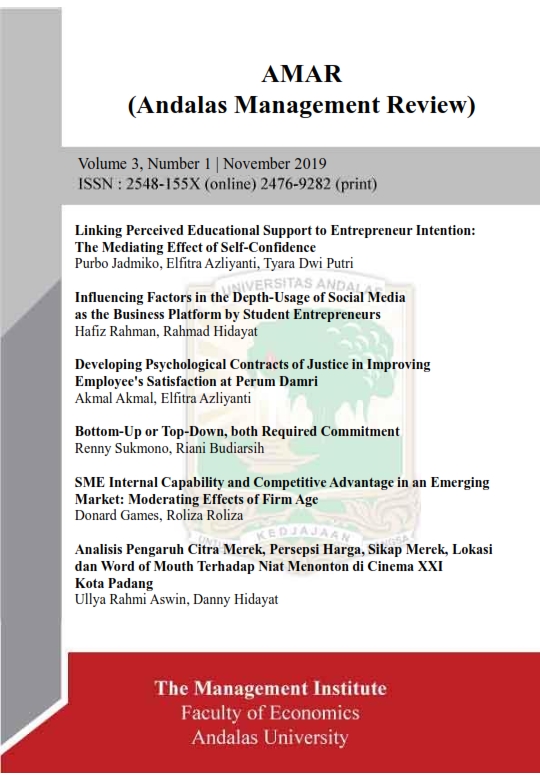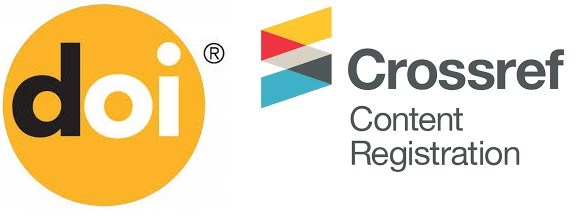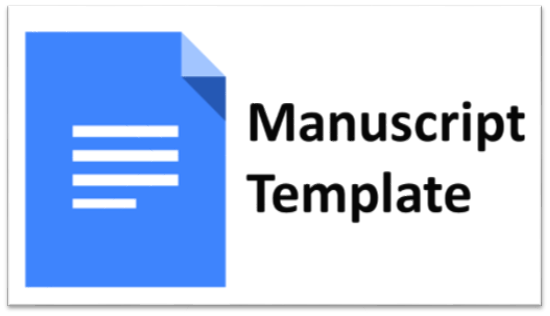SME Internal Capability and Competitive Advantage in an Emerging Market: Moderating Effects of Firm Age
Abstract
This study aims to determine the effect of small business internal capabilities on competitive advantage in which firm age was expected to moderate the relationship between these two constructs. The present study also considers the context of Indonesia as an emerging market economy as an important characteristic that can provide some additional perspectives related to SME competitive advantage. Here competitive advantage come from the resource-based view theory which sees SME capabilities will shape their competitiveness. The present study uses quantitative approach, using SmartPLS, by surveying 52 food SMEs in Padang, West Sumatra, Indonesia. It was found that SME internal capability was positively and significantly related to competitive advantage. Additionally, firm age moderated the relationship between SME internal capability and competitive advantage in young SME group (SMEs with the firm age less than 5 years), while this was not the case for old SME group (SMEs with the age more than 5 years). In an emerging market such as Indonesia, this may represent the urgency to consistently strengthen SME internal capability.
References
Avermaete, T., Viaene, J., Morgan, E. J., & Crawford, N., (2003). Determinants of innovation in small food firms. European Journal of Innovation Management, 6(1), 8–17.
Aziz, NNA., & Samad, Sarminah. (2016). Innovation and Competitive Advantage: Moderating Effects of Firm Age in Foods Manufacturing SMEs in Malaysia. Procedia Economics and Finance, 35, 256 – 266.
Barney, JB. (1991), Firm resource and sustained competitive advantage, Journal of Management, 17 (1), 99-120.
Dada, O., & Fogg, H., (2014), Organizational learning, entrepreneurial orientation, and the role of university engagement in SMEs. International Small Business Journal, 1–19.
Games, D. (2019). Can SME benefit from innovation in an emerging market economy? Academy of Entrepreneurship Journal, 25 (1).
Harris, M. N., Rogers, M., & Siouclis, A., (2003), Modelling firm innovation using panel probit estimators. Applied Economics Letters, 10(11), 683-686.
Higon, D.A., (2011), The impact of ICT on innovation activities: Evidence for UK SMEs. International Small Business Journal, 30 (6), 684-699.
Ismail, M. D., (2013), Learning orientation and trust in Small and Medium Enterprise (SME) Export Competitive. Asian Academy of Management Journal, 18(2), 153–179.
Kim, S. C., Lee, J. S., & Shin, K. I., (2015), The impact of project management assets on the VRIO characteristics of PM process for competitive advantage. International Journal of Productivity and Quality Management, 15(2), 153-168.
Williams, D., Hare, L., & UWI, M., (2012), Competitiveness of small hotels in Jamaica: An exploratory analysis. Journal of Eastern Caribbean Studies, 37(3/4), 71-96.
Zhang, M., (2006), Conceptualizing the learning process in SMES: Improving innovation through external orientation. International Small Business Journal, 24 (3), 299-323
Please find the rights and licenses in AMAR (Andalas Management Review). By submitting the article/manuscript of the article, the author(s) agree with this policy. No specific document sign-off is required.
1. License
The non-commercial use of the article will be governed by the Creative Commons Attribution license as currently displayed on Creative Commons Attribution-NonCommercial-ShareAlike 4.0 International License.
2. Author(s)' Warranties
The author warrants that the article is original, written by stated author(s), has not been published before, contains no unlawful statements, does not infringe the rights of others, is subject to copyright that is vested exclusively in the author and free of any third party rights, and that any necessary written permissions to quote from other sources have been obtained by the author(s).
3. User Rights
AMAR is to disseminate/published articles are as free as possible. Under the Creative Commons license, AMAR permits users to copy, distribute, display, and perform the work for non-commercial purposes only. Users will also need to attribute authors and AMAR on distributing works in the journal and other media of publications.
4. Rights of Authors
Authors retain all their rights to the published works, such as (but not limited to) the following rights;
- Copyright and other proprietary rights relating to the article, such as patent rights,
- The right to use the substance of the article in own future works, including lectures and books,
- The right to reproduce the article for own purposes,
- The right to self-archive the article,
- The right to enter into separate, additional contractual arrangements for the non-exclusive distribution of the article's published version (e.g., post it to an institutional repository or publish it in a book), with an acknowledgment of its initial publication in this journal (Andalas Management Review).
5. Co-Authorship
If the article was jointly prepared by more than one author, any authors submitting the manuscript warrants that he/she has been authorized by all co-authors to be agreed on this copyright and license notice (agreement) on their behalf, and agrees to inform his/her co-authors of the terms of this policy. AMAR will not be held liable for anything that may arise due to the author(s) internal dispute. AMAR will only communicate with the corresponding author.
6. Royalties
Being an open accessed journal and disseminating articles for free under the Creative Commons license term mentioned, author(s) aware that AMAR entitles the author(s) to no royalties or other fees.







